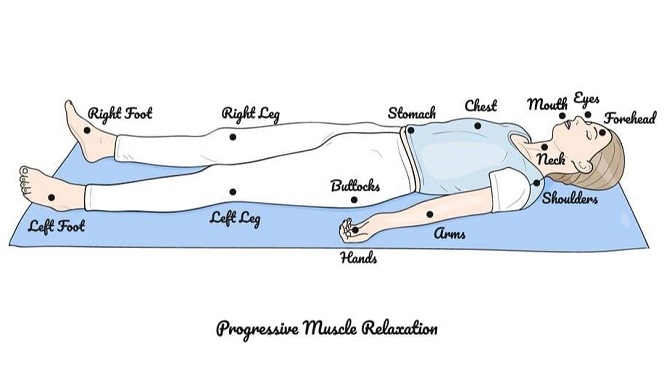Progressive muscle relaxation is a deep relaxation technique that has been effectively used to control stress and anxiety, relieve insomnia, and reduce symptoms of certain types of chronic pain. PMR was created by American physician Edmund Jacobson in the 1920s.

Once you are seated comfortably supported in a quiet place, follow the detailed instructions below:
1. Take 3 deep abdominal breaths, exhaling slowly each time. As you exhale, imagine the tension throughout your body flowing away.
2. Clench your fists. Hold for seven to ten seconds and then release for fifteen to twenty seconds. Use these same time intervals for all muscle groups.
3. Tighten your biceps by drawing your forearms up toward your shoulders and making a muscle with both arms. Hold… and then relax.
4. Tighten your triceps by extending your arms out straight and locking your elbows. Hold… and then relax.
5. Tense the muscles in your forehead by raising your eyebrows as far as you can. Hold… and then relax. Imagine your forehead muscles becoming smooth and limp as they relax.
6. Tense the muscles around your eyes by clenching your eyelids tightly shut. Hold… and then relax. Imagine sensations of deep relaxation spreading all around the area of your eyes.
7. Tighten your jaw by opening your mouth so widely that you stretch the muscles around the hinges of your jaw. Hold… and then relax. Let your lips part and allow your jaw to hang loose.
8. Tighten the muscles in the back of your neck by pulling your head back as if you were going to touch your head to your back (be gentle with this muscle group to avoid injury). Focus only on tensing the muscles in your neck. Hold… and then relax.
9. Take a few deep breaths and tune in to the weight of your head sinking into whatever surface it is resting on.
10.Tighten your shoulders by raising them up as if they were going to touch your ears. Hold… and then relax.
11. Tighten the muscles around your shoulder blades by pushing your shoulder blades back as if you were going to touch them together. Hold the tension in your shoulder blades…and then relax.
12.Tighten the muscles in your chest by taking in a deep breath. Hold for up to ten seconds…and then release slowly. Imagine any excess tension in your chest flowing away with the exhalation.
13.Tighten your stomach muscles by sucking your stomach in. Hold…and then release. Imagine a wave of relaxation spreading through your abdomen.
14.Tighten your lower back by arching it up (Omit this exercise if you have lower back pain.) Hold… and then relax.
15.Tighten your buttocks by pulling them together. Hold…and then relax. Imagine the muscles in your hips going loose and limp.
16.Squeeze the muscles in your thighs all the way down to your knees. Hold… and then relax. Feel your thigh muscles smoothing out and relaxing completely.
17.Tighten your calf muscles by pulling your toes toward you (flex carefully to avoid cramps). Hold… and then relax.
18.Tighten your feet by curling your toes downward. Hold… and then relax.
19.Mentally scan your body for any residual tension. If a particular area remains tense repeat one or two tense-relax cycles for that group of muscles.
20.Now imagine a wave of relaxation slowly spreading throughout your body, start at your head and gradually penetrating every muscle group all the way down your toes.
Sources: